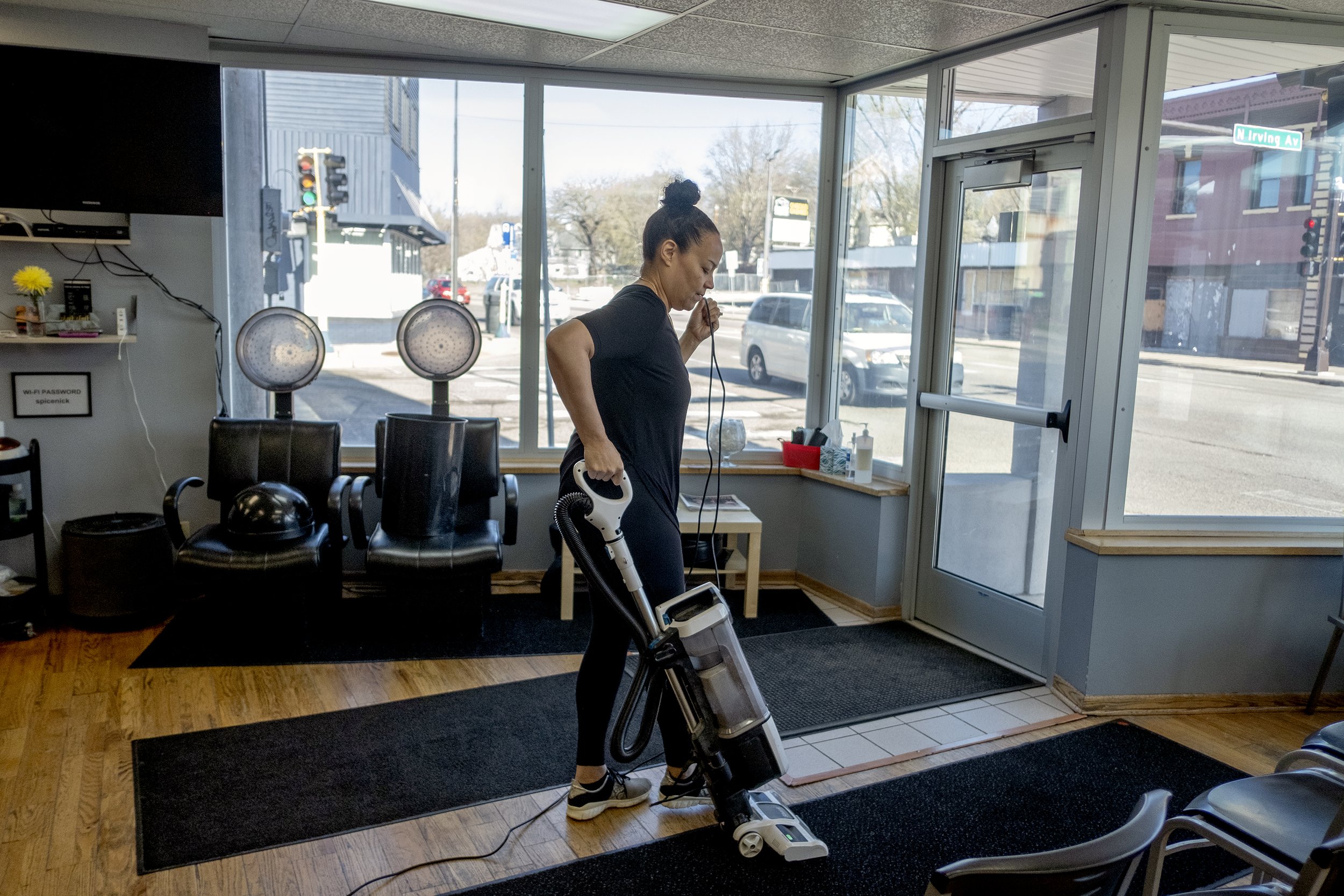Light rail plans put a hair salon’s generational wealth on hold
Lisa Spicer bought Dimensions in Hair from her dad and she intends to pass it to her grown children working with her.
Story and photos by David Pierini, Editor
As they considered how light rail would travel down West Broadway Avenue, engineers determined Lisa Spicer’s hair salon might have to be torn down in the name of progress and public transportation.
Spicer says no one has formally told her this.
No one involved in the Blue Line extension project has set foot in the Dimensions in Hair salon, started by her father and stepmother 32 years ago, to inform her of such a possibility, she said.
No engineer, manager, or elected leader with a vote on where the route might go, has sat with Spicer to discuss a value built on five generations in the hair business.
What price would they put on a space where her children grew up and two now occupy chairs, her son a barber and daughter, a nail technician with customers who travel from Iowa, Illinois and the Dakotas?
What of the stylists? Some are booked out for weeks because of their touch with natural hair. They learned from Spicer with a simple direction – follow what I do.
Minneapolis is a city short on spaces just for Black and Brown people. Salons and barber shops are sacred in community. They are consecrated with bustle, gentle laughter that flows from chair to chair and intimate conversation built on years of trust.
Spicer can’t put a price on this or the generational wealth her business creates. But she wishes someone tied to the project would pay her a visit.
“I shouldn’t have to find out from someone passing out a flier,” Spicer said of a meeting organizer who told her. “Yeah somebody saw an X on a map and said mine is one of the impacted buildings.
“I had one plan – buy the building from my dad, work here until I retire, support other stylists, bring my kids along and then they will inherit it. I never imagined I would be right here trying to ponder this. It’s very stressful.”
Mike and Doris Spicer bought the building 32 years ago. “When you own the building, nobody can move you,” she said.
‘Rondo 2.0’
Officials are expected to make a route recommendation later this year to connect the North suburbs with the downtown. Engineers are looking at two proposed routes to bring light rail through North Minneapolis, West Broadway Avenue and 21st Avenue, which would connect to Broadway right near Irving Avenue.
Spicer’s shop sits on the southeast corner of West Broadway and Irving avenues.
Many of the mostly Black-owned businesses on West Broadway are opposed to the West Broadway route. They fear the elimination of street parking, displacement during construction and the loss of a space for cultural events, like Juneteenth and Open Streets West Broadway.
The West Broadway Business and Area Coalition (WBC) earlier this year announced its intention to fight the West Broadway route, calling it “Rondo 2.0,” a reference to the once thriving Black neighborhood in Saint Paul that was cleaved in half by the construction of I-94 between 1956 and 1968.
Officials from the Met Council and Hennepin County have hosted numerous community meetings in driveways, churches and theaters. They say they are making every effort to incorporate citizen input into the planning and use the 21st Avenue route as an example of considering feedback for other routes.
“We are working in more ways than ever to center community voices in planning and decision-making, including through the Anti-Displacement Working Group, the Community Advisory Committee, the Business Advisory Committee, the community engagement cohort, as well as expansive direct outreach and communications efforts,” Met Council said in an unattributed written statement. “Strong community partnerships are essential to the success of this project, and we are committed to working with all our partners to deliver the best project possible to carry our region and state forward.”
Kristel Porter, WBC’s executive director, said few West Broadway business owners received notice of meetings. Nor were they ever visited by project leaders, Porter said.
Spicer cultivates a family feeling for her customers. The grandchildren and in some cases, the great grandchildren of original customers occupy the shop’s chairs.
Even with an anti-displacement work group, which is made up of a wide range of community leaders, no one from this group ever approached Spicer on what her business would need to survive a major transportation project. “Yes, there are a lot of meetings, that’s great,” Porter said. “But the reality is you’re not really meeting people where they’re at. None of these business owners are going to make it to any of those meetings because they’re trying to run a business.
“You’re the one who gets paid the big bucks. Go and have a conversation with them. Sit down next to them, pull up a chair and have a deep conversation with them about how this is going to impact them. No one is telling them what impact means. Lisa Spicer was crying (at a meeting). “My building is impacted and you won’t tell me what that means?’”
One official privately said the lack of specific talks with business owners is intentional because of how details will change “many times” during the process. For now, there are 18- page packets available at meetings that list rights, benefits and explain relocation assistance. It is dated January 2015.
Marked in pink
The demolition of Dimensions in Hair is not imminent. Impact depends on the eventual route.
To get a partial glimpse on impact, two 3D models of each proposed route designate the buildings identified for possible tear down with the color pink. Spicer’s building is pink on the West Broadway map to make way for a station, but appears unscathed by the 21st Avenue route.
Running light rail down West Broadway is a tight squeeze, opponents say. In some parts of the corridor, a slim sidewalk separates the road from a business’s front door. Business owners wonder whether some of the older buildings can survive the rumble of heavy construction. Cracks emerged at one condominium complex on the incomplete Southwest light rail line.
An even bigger question in Spicer’s mind is whether vulnerable people can survive the changes that come with a large transportation project. With light rail, transportation officials say, comes increased access to jobs, schooling and other services not found in North Minneapolis. It can also spur additional investment in housing, local businesses and amenities.
It can also price out residents living on the margins, leaders like Porter say.
The challenges residents continue to live with come from a lack of investment. Porter and Spicer both wonder if the intention of light rail really is designed to lift a community or allow others to more easily pass through it?
“We can already see change happening, but why did it take light rail to suddenly help people create spaces that can help them enjoy living here?” Spicer said. “Drug use has exploded, guns, shootings and all this craziness and they’re not doing anything about it. You’re running light rail through communities, not helping them stay alive while these changes are coming.”
On a recent Saturday, salon chairs were full. Seione Kimbrough, Spicer’s daughter, has clients driving from other states for mani-pedis.
‘Nobody can make you move’
Mike, the son and grandson of stylists, opened Dimensions with his wife, Doris, in 1991. In a 2017 interview with North News on the 25th anniversary of their shop, Doris Spicer said when customers walked in, they were “treated like kings and queens.”
They were not content with renting. “When you own the building, nobody can move you,” she said.
Lisa Spicer learned the business by spending summers in Indiana, working in a salon owned by her grandmother and great grandmother. As an adult, she decided hair would be her career. After beautician school, she accepted an invitation to work with her father and step-mother.
Son Jaedyn Spicer and daughter Seione Kimbrough were babies when they came to the salon with their mother, occupying a playpen set up next to her chair. Lisa Spicer said working with family has been a blessing.
“We feel like we mean so much to the people who come here and use us as a resource. Yes, it’s like therapy and like family,” Seione Kimbrough said. “So, you feel like you’re minimized down to just something on a map. I watched my mom and my grandpa put so much of their lives into something and have someone else, a higher-up or whatever, say, ‘make it go there.’ It’s heartbreaking.”
Spicer is in her shop every Monday morning for a few hours of cleaning.
Editor’s note: A photograph on the cover of the May 26 North News shows a 3D map used by Blue Line officials to help the public understand how light rail could impact the buildings along West Broadway Avenue North. That map below incorrectly identified the location of Dimensions in Hair salon; the salon is to the right across the side street. The salon is slated for demolition under one of the two routes proposed for the Blue Line extension. North News regrets not noticing the error.






